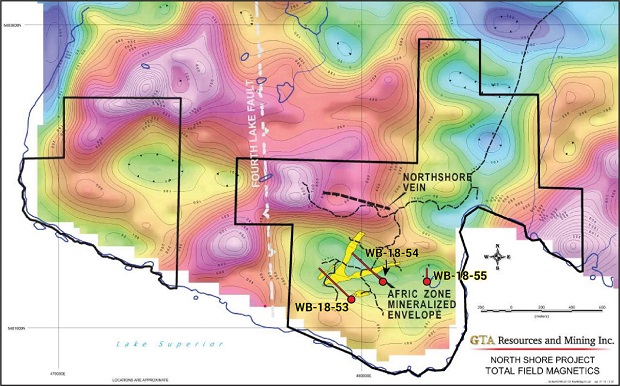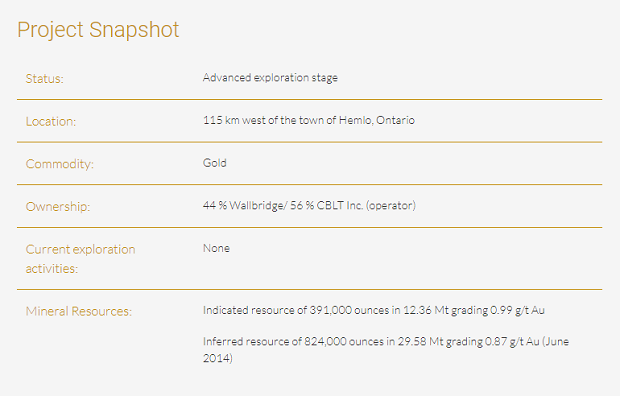Wallbridge Mining Company Ltd.
Northshore Project

The Northshore project covers 2.55 km2 and is located along the southern margin of the Hemlo-Schreiber greenstone belt, approximately 60 kilometres west of the high-grade Hemlo mine (Barrick Gold) which has produced over 21 million ounces of gold.
The project hosts a number of known zones of gold mineralization including the former producing North Shore Mine and the Afric Zone, the latter the recent focus of activity. The structurally controlled, intrusive-hosted gold mineralization on the Northshore project shares similarities with gold deposits in the Kirkland Lake and West Timmins areas of Ontario.

Brief History
One of the oldest known gold discoveries (around 1898) in Ontario was on the Northshore property. A small high-grade (16-20 g/t) gold mining operation was centered on this discovery during the 1930's. Historic records indicate that Northshore Gold Mines produced 3.808 tons of gold ore from the Northshore Zone at an average grade of 0.64 oz/ton (21.80 g/t gold) between 1935 and 1937. The historic mill, located on the shores of Lake Superior was destroyed by a fire during the 1980's.
From 1988 to 1992, Noranda Exploration and Hemlo Gold Mines held an option of the property. Noranda identified and conducted initial drill testing on five gold-bearing zones in addition to the Northshore Zone. This work led to the discovery of the Afric Zone, located at the intersection of two property scale gold-bearing features. Noranda estimated an in-situ geological resource of 2.0 Mt grading 2.20 g/t Au (~135,000 ounces) (not compliant with NI 43-101) for the Afric Zone between surface and a vertical depth of 150 metres.
Subsequent trenching and drilling by Cyprus Canada Ltd. and American Bonanza Gold Corp. (“American Bonanza”) between 2002 and 2007 identified extensions to the Afric, Northshore and Zones 2-5 on the property, all of which remain open to depth. The final hole of American Bonanza's 2007 drill program returned an intercept of 24.75 g/t Au over 3.0 metres at a vertical depth of less than 20 metres vertical depth from Zone 2 in an area of very limited historic drilling.
Balmoral acquired American Bonanza’s Canadian assets in late 2010 and in 2011 granted GTA Resources and Mining (“GTA”, now CBLT Inc.) an option to earn a working interest in the property. Between 2011 and 2014, GTA conducted four phases of exploration and drilling on the property (103 drill holes), which successfully expanded the Afric Zone and several related high-grade gold mineralized structures. In 2014, GTA reported an initial NI 43-101 mineral resource estimate for the Afric Zone (See Mineral Resources Section).
In 2015, GTA contracted a study of the Afric Zone higher grade, near-surface gold mineralization. Results from this study included the outlining of two proposed shallow pits (using a cut-off grade of 1.6 g/t Au) labeled West Pit and East Pit. In 2016, GTA completed a drilling program of 51 holes totaling 1,463 metres focusing on the delineation and expansion of the near-surface, higher grade mineralization of the Afric Zone. In addition, preliminary metallurgical test work conducted on two composited drill core samples indicated excellent recoveries varying from 94.8% to 99.6% over a 24-hour retention time.
In 2018, GTA completed 3 drill holes, which included 2 long holes testing the Afric Zone beneath the previously outlined mineral resource. They successfully expanded the deposit, leaving it open for additional delineation at depth, in particular to the east and northeast.

Geology and Mineralization
The Northshore project is located along the southern landward edge of the Hemlo-Schreiber greenstone belt, along the western projection of a series of major regional structures which to the east host the multi-million-ounce Hemlo gold deposits.
The project is underlain by a complex assemblage of felsic intrusive rocks which intrude into a sequence of felsic to intermediate intrusive rocks. A broad zone, over 2 kilometres across, of alteration and disseminated sulphide mineralization hosts the Afric Zone and occurs within and surrounding a quartz-feldspar porphyry unit. A major regional syenite body occurs along the northern and western margin of the property and several different intrusive phases ranging from mafic to felsic in composition are seen to be associated with this body.
Gold mineralization within the Afric Zone is associated both with quartz-carbonate veining and with extensive zones of disseminated to blebby pyrite hosted by a quartz-feldspar porphyry body. The mineralization is associated with pervasive iron-carbonate alteration and variable sericite and potassic alteration, the latter particularly prevalent in proximity to the syenite body. Gold mineralization and alteration is typically most heavily concentrated at the intersection of NE and NW trending structures.
Locally spectacular visible gold mineralization is observed in association with multi-phase quartz and quartz-carbonate veins located along several prominent structures - the Audney and Caly vein systems. These two veins systems trend ENE and appear to be conjugate dilational structures (“ladder-type veins) located within the broader Afric Zone. Gold mineralization within these veins is commonly in the form of relatively coarse native gold mineralization. The veins can host lesser pyrite, traces of arsenopyrite, tourmaline and chalcopyrite. The veins themselves range from 10 cm to over 2.5 metres in width and are commonly surrounded by a number of narrower veins, veinlets and fractures which also appear to be gold bearing.
The high-grade quartz veins which host the historic Northshore mine are roughly east-west trending, roughly parallel to the trend of the Afric Zone. These veins have seen relatively limited modern exploration but in general terms appear similar to the Audney and Caly systems.
Gold mineralization is also found on the project associated with base metal sulphide veins which locally carry strongly elevated silver values. Previous workers have suggested that this style of mineralization may be related to volcanogenic massive sulphide mineralization like that one at the former producing Winston Lake Zn-Cu-Ag-Au system located north of the town of Schreiber.
Mineral Resources
In 2014, GTA reported an initial NI 43-101 mineral resource estimate for the Afric Zone (Technical Report on the Mineral Resources of the Northshore Property, dated June 30, 2014).
The geological model was constructed from vertical and horizontal cross- sections spaced 25 metres apart using Gemcom software. A broad mineralized solid was utilized to constrain the resource estimation within the Afric Zone, excluding the adjacent Gino and Northshore vein structures. Several northwesterly trending, barren to weakly mineralized, post-mineral diabase dykes cross-cut the mineralized Afric Zone, and these features were also modelled.
The resource estimate was based on a drilling database including a total of 13,777 samples from 100 diamond drill holes, representing approximately 19,448 metres of drilling. The drilling included surface holes completed from the 1990s through 2013. Of these, 53 drill holes totaling 13,000 metres were completed by GTA from 2011 to 2013.
The mineral resource was constrained by wireframes of the favourable host lithologies. Both the Indicated and Inferred resources were calculated using the GTA holes, as well as the historical data, which included drill holes completed since 1990. Some of the historic holes were not under the same QA/QC scrutiny as the GTA drilling programs. Gold grades were interpolated into 10 x 10 x 5-metre blocks using a combination of ordinary kriging (“OK”) and indicator kriging (“IK”) estimation methods.
The cut-off grade of 0.50 g/t gold was highlighted as GTA believed that this value represented a reasonable cut-off grade for exploiting a bulk tonnage gold deposit, such as the Afric Zone, located in northern Ontario with excellent existing infrastructure. Further details of the resource estimate, including Inferred and Indicated categories, and using cut-off grades ranging from 0.20 to 1.20 g/t gold are summarized in the following tables.


Notes:
- A top cut of 180 g/t was applied to Au assays before compositing (only 2 samples were above the cap grade).
- Mineral resources which are not mineral reserves do not have demonstrated economic viability. The estimate of mineral resources may be materially affected by environmental, permitting, legal, title, socio-political, marketing, or other relevant issues. Mineral resource estimate figures may not total due to rounding issues.
- The quantity and grade of reported inferred mineral resources in this estimation are uncertain in nature and there has been insufficient exploration to define these inferred resources as an indicated or measured mineral resource and it is uncertain if further exploration will result in upgrading them to an indicated or measured mineral resource category.
- The mineral resources were estimated using the Canadian Institute of Mining, Metallurgy and Petroleum (CIM), CIM Standards on Mineral Resources and Reserves, Definitions and Guidelines prepared by the CIM Standing Committee on Reserve Definitions and adopted by CIM Council November 27, 2010.
- Resources were estimated using 2.5-metre composites within a Block Model with block dimensions of 10x10x5m, and using a combination of OK and IK grade interpolation method. Seven overlapping grade intervals were identified within the block model. The lower and higher grade mineralized intervals were subdivided at a statistically-determined grade of 1.4 g/t gold. Without comprehensive metallurgical results, recoveries were assumed to be 100%.
- Mineral resources were classified as Indicated if estimated in the first two passes using search dimensions up to ½ the semivariogram range. A minimum of four composites from at least two different holes were required within the search ellipse to estimate a block. All other blocks were classified as Inferred.


Source: https://wallbridgemining.com/our-projects/other-gold-assets/northshore/

|
IT Technician (Support IT), Fénélon Project
The technician IT will report to the Project Manager, the schedule is 4/3.